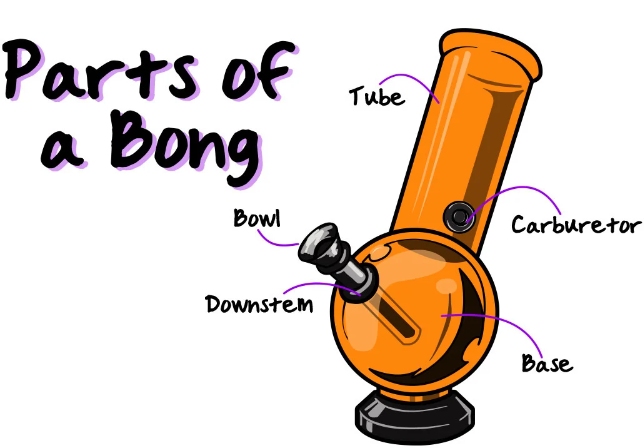We use cookies to make your experience better. To comply with the new e-Privacy directive, we need to ask for your consent to set the cookies. Learn more.
Decoding the Diversity of Bongs: An In-Depth Guide to Every Conceivable Type of Bong
Decoding the Diversity of Bongs: An In-Depth Guide to Every Conceivable Type of Bong
The world of cannabis consumption is rich with variety, with countless ways to enjoy the herb's potent effects. One such method that has stood the test of time is the bong. Bongs are as diverse as the individuals who use them, each offering a unique smoking experience. This comprehensive guide will delve into the vast array of bongs that exist, exploring their individual characteristics and the unique advantages they bring to a cannabis enthusiast's repertoire.
Understanding the Bong: An Overview
Before we plunge into the different types of bongs, let's first understand what a bong is. A bong, in its simplest form, is a water filtration device used to smoke cannabis. The primary role of a bong is to filter and cool the smoke from the burning cannabis through water, delivering a smoother and more enjoyable smoking experience.
The term 'bong' itself is believed to have derived from the Thai word 'baung', which refers to a cylindrical bamboo tube used for smoking. However, the concept of water filtration in smoking devices is not exclusive to any one culture, with early forms of bongs discovered across various parts of the world, from Africa to Central Asia.
The components that make up a bong can vary, but the basic elements include a water chamber, a tube, a downstem, and a bowl. The water chamber holds the water through which the smoke is filtered, the tube is used to draw the smoke into the user's mouth, the downstem connects the bowl with the water chamber, and the bowl is where the cannabis is packed and burnt.
Now, let's delve into the myriad types of bongs that exist, each with its unique attributes and benefits.
The Expansive World of Bongs: Various Types and Their Features
Bongs can be categorised based on various factors including their size, material, design, and added functionalities. Let's explore these categories in detail.
Bongs by Size: Small, Medium, and Large
Size plays a crucial role in determining the type of bong that suits you best. Bongs can range from small, portable devices to large, elaborate setups.
Small Bongs: Compact and easy to use, small bongs are perfect for those who prefer discretion or require a travel-friendly option. These mini bongs generally measure under 8 inches in height, making them perfect for on-the-go usage. However, their small size also makes them more delicate and a bit challenging to clean.
Medium Bongs: Averaging between 10 to 14 inches in height, medium bongs strike a balance between portability and functionality. They offer a smoother smoking experience compared to small bongs and are more durable. If you're looking for an everyday bong that offers a great balance of size and performance, a medium bong is the way to go.
Large Bongs: Large bongs are the kings of the bong world, offering powerful hits and an impressive presence. They provide superior airflow due to their longer smoke chambers, reducing throat and lung irritation. However, they can be a bit cumbersome to handle and clean, making them a better fit for experienced users.
Bongs by Material: Glass, Acrylic, Ceramic, and More
The material of a bong greatly influences its durability, performance, and aesthetic appeal. The most common materials used to make bongs are glass, acrylic, ceramic, and silicone.
Glass Bongs: Glass bongs are the most popular choice among cannabis enthusiasts due to their superior performance and aesthetic appeal. They offer clean, smooth hits as the glass does not interfere with the flavour of the smoke. Additionally, glass bongs can be crafted into a multitude of shapes and sizes, making them as much a work of art as a smoking device.
Acrylic Bongs: Acrylic bongs are a cost-effective and durable alternative to glass bongs. They are nearly unbreakable, making them ideal for those prone to accidents. However, they do not offer the same clean, pure hits as glass bongs, as the plastic can slightly alter the taste of the smoke.
Ceramic Bongs: Ceramic bongs are known for their unique designs and high-quality hits. They can be moulded into creative shapes and are often handmade, adding an artistic flair to your smoking experience. However, they tend to be heavier and more fragile than other types of bongs.
Silicone Bongs: Silicone bongs are gaining popularity due to their durability and affordability. They are shatter-proof, dishwasher-safe, and foldable for easy transport. While they do not offer as clean a hit as glass bongs, they still provide a decent smoking experience.
Bongs by Design: Beaker, Straight Tube, Fat Can, and More
Bongs come in a variety of designs, each offering a unique aesthetic appeal and functionality. Here are some of the most common bong designs:
Beaker Bongs: Resembling a scientific beaker, these bongs have a wide base for stability. They offer a large water reservoir for better filtration and cooling of the smoke.
Straight Tube Bongs: As the name suggests, these bongs have a straight tube design. They are easy to clean and provide the user with more control over the size of each hit.
Fat Can Bongs: Also known as chamber bongs, these bongs feature a wide cylindrical body and a large central chamber with one or more percolators for superior filtration.
Recycler Bongs: These bongs recycle the water through multiple interconnected chambers, continuously filtering and cooling the smoke for smoother hits.
Gravity Bongs: These bongs use gravity to fill the chamber with smoke. They can be made from various materials and offer a unique smoking experience.
Modular Bongs: These bongs have interchangeable parts, allowing for full customisation. They can be quickly assembled or disassembled for easy cleaning and transport.
Bongs by Function: Percolator, Themed, and More
Beyond the basic design, many bongs come with added features that enhance their functionality and your smoking experience.
Percolator Bongs: These bongs have a built-in percolator, a device that cools smoke before it enters your lungs. Percolators come in various shapes and sizes, each offering a slightly different smoking experience.
Themed Bongs: Themed bongs are designed to resemble various objects, characters, or themes. These bongs add a fun and artistic touch to your smoking experience.
Ice-Catcher Bongs: These bongs feature a built-in ice catcher that allows you to add ice to the bong. The ice cools the smoke, providing smoother and cooler hits.
Splash Guard Bongs: These bongs feature a splash guard that prevents water from bubbling up into the mouthpiece, ensuring a dry and enjoyable smoking experience.
The Anatomy of a Bong: Breaking Down its Components
Now that we've explored the diverse types of bongs, let's delve into their anatomy. Understanding the components of a bong will allow you to make an informed choice when buying one and ensure you use it correctly and maintain it properly.
Bowl Piece: The bowl piece is where the action starts. It's where you pack your finely ground cannabis ready to be lit and smoked.
Ash Catcher: An optional attachment, the ash catcher's job is to trap the ash and debris that fall through from your bowl piece, preventing them from entering your mouth or lungs.
Joint: The joint is the part of the bong that secures the downstem inside the base of the bong. The top of the joint holds your bowl piece inside the downstem.
Downstem: The downstem is a tube that carries the smoke from the bowl into the water in the base of the bong. Some bongs feature removable downstems for easy cleaning and replacement.
Percolator: A percolator is a device that further filters and cools the smoke after it passes through the water in the base of your bong. It's a key feature in many high-end bongs.
Splash Guard/Ice Catcher: A splash guard prevents water from bubbling up into the mouthpiece when you take a hit. Some bongs also feature an ice catcher, which allows you to add ice to further cool the smoke.
Mouthpiece: The final stop for the smoke before it reaches your lungs, the mouthpiece is designed to be comfortable for your lips and easy to draw smoke from.
Bongs and Their Usage: A Step-by-Step Guide
Using a bong may seem complex, but with a bit of practice, it becomes second nature. Here's a detailed step-by-step guide on how to use a bong:
Step 1: Fill the Bong with Water: Begin by filling your bong with water. The water should be enough to fully submerge the downstem, but not so much that it splashes into your mouth when you inhale.
Step 2: Prepare the Cannabis: Use a grinder to break down your cannabis into a fine consistency. This will ensure optimal airflow when you light it.
Step 3: Pack the Bowl: Carefully pack your ground cannabis into the bowl, ensuring it's tight enough to stay lit but loose enough to allow smoke to pass through.
Step 4: Light the Bowl: As you begin to inhale through the mouthpiece, light the corner of the cannabis in the bowl. The inhalation will pull the flame into the bowl, lighting the cannabis.
Step 5: Inhale and Enjoy: Once the bong is filled with smoke, continue to inhale. The smoke will be drawn through the water, filtered, cooled, and then flow into your lungs.
Bong Maintenance: Keeping Your Bong Clean
Regular maintenance is crucial to ensure the longevity and optimal performance of your bong. Here's a brief guide on how to clean your bong:
To start, remove the bowl and downstem from your bong and immerse them in isopropyl alcohol. Then, combine isopropyl alcohol and salt inside the empty bong using a 4:1 ratio. Plug the holes with your hands and shake the water pipe for up to five minutes. Rinse with water and repeat as needed. Finally, rinse your accessories off with hot water and reassemble your bong.
Frequently Asked Questions
Are Silicone Bongs Safe?
Yes, silicone bongs are safe to use. They're made from food-grade silicone, which is non-toxic and won't leach chemicals into your smoke or water. Plus, they're shatter-resistant, making them an excellent choice for those prone to accidents.
Can You Smoke Out of a Plastic Bong?
You can smoke out of a plastic bong, but ensure it's made from food-grade plastic and doesn't contain harmful chemicals. Some plastics can release toxins when heated, so choosing a safe option is crucial.
Are Glass Bongs Better Than Plastic Bongs?
Many users prefer glass bongs as they offer cleaner, pure hits and don't feel as cheap as plastic. However, plastic bongs are typically cheaper and more durable.
Are Ceramic Bongs Safe?
Ceramic bongs are safe to use as long as they're made from food-grade materials. Ceramic is a durable material that doesn't leach chemicals into your smoke or water.
What Is the Best Material for a Bong?
The best material for a bong depends on your personal preference. Some users prefer glass for its purity and aesthetics, while others prefer plastic or silicone for their durability and affordability.
Wrapping Up
Bongs offer a unique smoking experience, enhancing the effects of cannabis and allowing for a smoother, more enjoyable hit. With such a diverse range of bongs available, from simple to intricate, there's certainly a bong to suit every cannabis enthusiast's preferences. Whether you're a seasoned user or new to the world of bongs, this guide will help you navigate the vast world of bongs and find the perfect match for your cannabis needs. Remember, the best bong is the one that best fits your lifestyle, preferences, and budget. Happy smoking!



![[Updated] Old-School Bong: How to Make A Water Bottle Bong?](https://www.olivastu.com/media/magefan_blog/bottle-featured.jpg)

